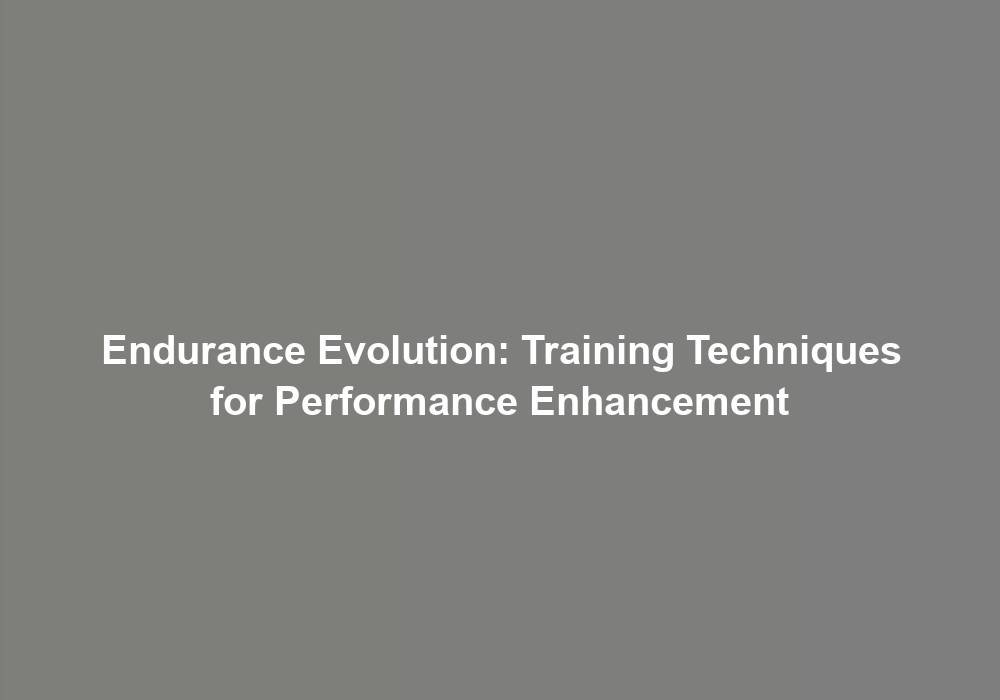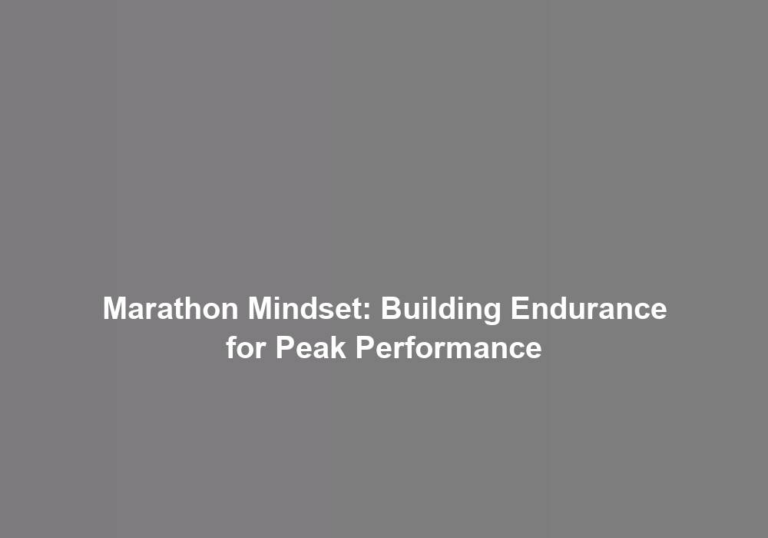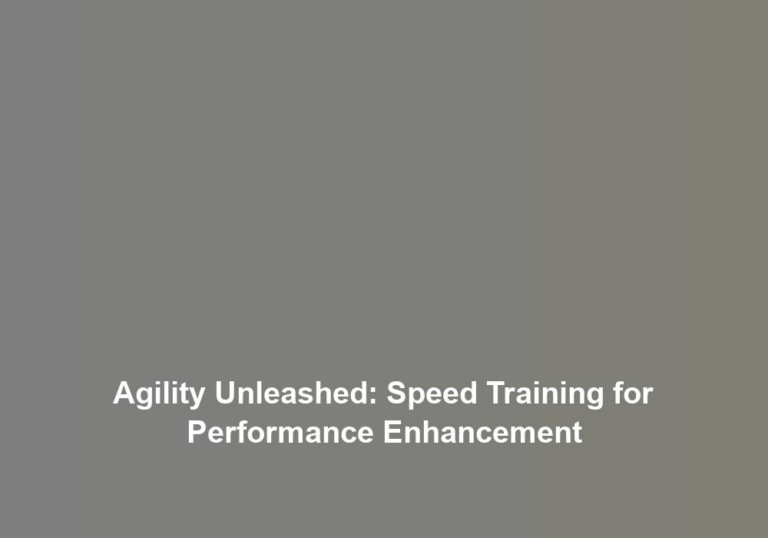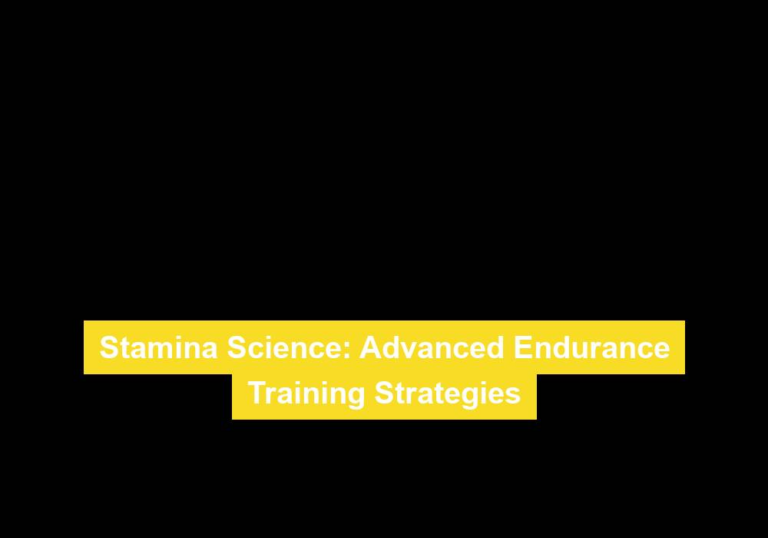Endurance Evolution: Training Techniques for Performance Enhancement
YouG??ve probably heard of elite marathon runners who have significantly improved their race times after implementing altitude training into their regimen. However, have you ever wondered what specific training techniques and principles are behind such remarkable performance enhancements? Whether youG??re a competitive athlete or a recreational runner looking to push your limits, understanding the evolution of endurance training techniques is crucial for achieving peak performance. From advanced interval workouts to optimizing nutrition and recovery, the methods for enhancing endurance have evolved significantly in recent years. But what are the latest strategies that can take your performance to the next level?
Understanding Endurance Training Principles
To improve your endurance training, itG??s essential to understand the principles that drive performance enhancement. Endurance adaptation is a key aspect of training that leads to improved aerobic capacity. When you engage in endurance training, your body undergoes various physiological changes to adapt to the increased demands placed on it. These changes include improvements in cardiovascular function, muscle fiber recruitment, and energy utilization. Understanding these principles is crucial for optimizing your training and achieving better performance outcomes.
Aerobic capacity, often referred to as VO2 max, is a measure of the maximum amount of oxygen your body can utilize during intense exercise. Endurance training plays a significant role in enhancing this capacity. By regularly engaging in activities such as running, cycling, or swimming, you stimulate adaptations in your cardiovascular and respiratory systems, leading to improved oxygen delivery to working muscles. This, in turn, allows you to sustain higher exercise intensities for longer durations.
To improve your endurance training, focus on gradually increasing the duration and intensity of your workouts to challenge your body and stimulate adaptation. Incorporate a mix of steady-state endurance activities and interval training to target different energy systems and enhance overall performance. By understanding these principles and applying them to your training regimen, you can effectively boost your endurance capacity and achieve your performance goals.
Implementing Advanced Interval Workouts
Now that youG??ve grasped the fundamentals of interval training, itG??s time to elevate your workouts with advanced interval techniques. YouG??ll explore the specific benefits of advanced interval workouts, optimal timing for intervals, and effective recovery strategies. These points will provide you with the necessary insights to maximize the impact of your interval training regimen.
Interval Workout Benefits
Implementing advanced interval workouts can significantly enhance athletic performance by maximizing cardiovascular endurance and improving speed and power. The benefits of advanced interval workouts include:
- Increased Interval Intensity: By progressively increasing the intensity of intervals, you can push your body to adapt to higher levels of exertion, leading to improved performance.
- Enhanced Progressions: Structured interval workouts allow for systematic progressions, ensuring continual improvement in endurance and speed.
- Mental Fortitude: Enduring challenging interval sessions builds mental toughness, enhancing your ability to push through fatigue during competition.
- Improved Interval Training: Advanced interval workouts optimize the efficiency of training, allowing for greater gains in shorter periods.
- Enhanced Recovery: Strategic interval training promotes faster recovery times, enabling you to train more frequently and with higher quality.
These benefits demonstrate the value of implementing advanced interval workouts for maximizing athletic performance.
Proper Interval Timing
Transitioning from maximizing athletic performance through advanced interval workouts, proper interval timing is essential for optimizing training effectiveness and achieving desired results. Optimal rest between intervals allows for adequate recovery, ensuring that each interval can be performed at the highest intensity. Effective pacing during intervals is crucial for maintaining energy levels and achieving consistent performance throughout the workout. To achieve optimal results, itG??s important to carefully time both work and rest intervals, ensuring that they align with your specific training goals. By paying attention to your timing and pacing, you can maximize the benefits of interval training, leading to improved endurance, speed, and overall athletic performance. Remember, the key to success lies in the precision and consistency of your interval timing and pacing.
Recovery Strategies
To optimize the effectiveness of advanced interval workouts, it is essential to incorporate strategic recovery techniques that facilitate maximal performance during each interval. Implementing proper recovery strategies is crucial for enhancing endurance and overall performance. Here are some key regeneration techniques to consider:
- Active Recovery: Engage in low-intensity exercises such as walking or cycling between intervals to promote blood circulation and remove metabolic by-products.
- Passive Recovery: Allow for complete rest or light movement to prevent muscle fatigue and ensure readiness for the next interval.
- Hydration and Nutrition: Replenish fluids and consume carbohydrate-rich snacks to restore energy levels and support muscle recovery.
- Stretching and Foam Rolling: Perform dynamic stretches and utilize foam rollers to reduce muscle tension and prevent injury.
- Sleep and Rest: Prioritize adequate sleep and rest to optimize the bodyG??s natural recovery processes and promote overall performance enhancement.
Optimizing Nutrition for Endurance Performance
To optimize your nutrition for endurance performance, fueling for endurance, hydration for performance, and recovery nutrition essentials are essential points to focus on. Ensuring that you have the right balance of carbohydrates, proteins, and fats to fuel your body for long periods of exertion is crucial. Additionally, staying properly hydrated and replenishing your body with the right nutrients after a workout are key elements in maximizing your endurance performance.
Fueling for Endurance
Optimizing your nutrition for endurance performance is crucial for maximizing your training outcomes and achieving peak physical condition. When fueling for endurance, consider the following:
- Carb Loading: Prioritize consuming complex carbohydrates like whole grains, fruits, and vegetables to store glycogen for sustained energy during endurance activities.
- Energy Gels: Use energy gels during long runs or rides to maintain glucose levels and delay fatigue.
- Proper Hydration: Stay adequately hydrated before, during, and after exercise to support optimal performance and recovery.
- Electrolyte Balance: Ensure you replenish essential electrolytes lost through sweat to prevent muscle cramps and maintain proper nerve function.
- Balanced Nutrition: Consume a well-rounded diet with lean proteins, healthy fats, and a variety of vitamins and minerals to support overall endurance and health.
Hydration for Performance
Proper hydration plays a critical role in optimizing your endurance performance, ensuring that your body can sustain peak physical condition during training and competition. Effective hydration strategies are essential for maintaining performance and preventing dehydration. Electrolyte balance is crucial, as it supports muscle function and overall hydration levels. To optimize your hydration, focus on regular fluid intake before, during, and after exercise. ItG??s important to tailor your fluid intake to your individual sweat rate, environmental conditions, and exercise intensity. Including electrolyte-rich drinks or snacks can help maintain the necessary electrolyte balance. Monitoring urine color can also provide valuable insights into your hydration status. By prioritizing appropriate hydration strategies and electrolyte balance, you can enhance your endurance performance and overall training outcomes.
Recovery Nutrition Essentials
Consider incorporating nutrient-dense foods and beverages into your post-exercise routine to optimize recovery and support your endurance performance. Post workout nutrition plays a crucial role in replenishing glycogen stores, repairing muscle tissue, and rehydrating the body. To enhance your recovery and performance, focus on the following essentials:
- Protein: Consume a protein-rich snack or meal within 30 minutes to 2 hours after exercise to support muscle repair and growth.
- Carbohydrates: Replenish glycogen stores by consuming carbohydrates alongside protein within the post-exercise window.
- Hydration: Rehydrate with water, coconut water, or a sports drink containing electrolytes to replace fluids lost during exercise.
- Healthy Fats: Incorporate sources of healthy fats such as nuts, seeds, or avocado to provide sustained energy and aid in nutrient absorption.
- Micronutrients: Consume fruits and vegetables rich in vitamins, minerals, and antioxidants to support immune function and overall recovery.
Incorporating Strength and Resistance Training
Incorporate strength and resistance training into your workout routine to enhance muscle development and overall athletic performance. Resistance progressions are key to continually challenging your muscles and promoting growth. Start with a weight that allows you to perform 8-12 reps with proper form, gradually increasing the resistance as you get stronger. This approach not only builds strength but also contributes to injury prevention by enhancing joint stability and muscular balance.
Power development is essential for athletes across various disciplines. Incorporating explosive movements like plyometric exercises and Olympic lifts can significantly improve your power output. These exercises engage fast-twitch muscle fibers, enhancing your ability to generate force quickly, which is crucial for sports requiring sudden bursts of energy.
Furthermore, focusing on muscular endurance through resistance training can help delay the onset of fatigue during prolonged physical activity. Performing high-repetition sets with lighter weights or bodyweight exercises can improve your muscle endurance, allowing you to maintain performance levels for longer durations.
To maximize the benefits of strength and resistance training, itG??s important to ensure proper form and technique. Consider working with a certified trainer to learn the correct execution of exercises and to develop a personalized training plan tailored to your athletic goals.
Incorporating strength and resistance training into your workout routine not only enhances physical performance but also boosts confidence and mental resilience, contributing to an overall sense of athleticism and well-being.
Utilizing Recovery and Regeneration Techniques
Maximizing your athletic performance requires strategic implementation of recovery and regeneration techniques. To ensure you optimize your training efforts, itG??s crucial to incorporate effective recovery techniques and regeneration methods into your routine. Here are some essential strategies to help you enhance your performance and overall well-being:
-
Active Recovery: Engage in low-intensity activities such as walking, swimming, or cycling to promote blood flow and facilitate muscle repair without causing additional stress.
-
Hydration and Nutrition: Proper hydration and a well-balanced diet rich in nutrients are vital for replenishing energy stores, repairing muscle tissue, and supporting overall recovery.
-
Quality Sleep: Prioritize adequate and restorative sleep to allow your body to repair and rebuild tissues, regulate hormones, and consolidate learning and memory.
-
Massage and Foam Rolling: Incorporate regular massage sessions or foam rolling exercises to reduce muscle tension, improve flexibility, and enhance circulation for faster recovery.
-
Mindfulness and Stress Management: Practice stress-reducing techniques such as meditation, deep breathing, or yoga to lower cortisol levels, promote relaxation, and aid in the recovery process.
Monitoring and Tracking Performance Metrics
To optimize your training and improve your athletic performance, it is essential to systematically monitor and track key performance metrics. Performance tracking allows you to gather valuable data that can be analyzed to identify trends, strengths, and areas for improvement. By consistently tracking your performance metrics, you can make informed decisions about your training, leading to better results and a more efficient use of your time and energy.
| Performance Metric | Tracking Frequency | Analytical Approach | Actionable Insights |
|---|---|---|---|
| Heart Rate | Daily | Trend analysis | Adjust training intensity |
| Running Pace | Weekly | Comparative analysis | Evaluate progress |
| Distance Covered | Monthly | Longitudinal analysis | Set new distance goals |
| Recovery Time | After each workout | Descriptive analysis | Adjust rest intervals |
Monitoring your heart rate daily, for example, allows you to analyze trends and adjust your training intensity accordingly. Weekly tracking of running pace lets you compare your performance over time, providing insights into your progress. Monthly distance covered tracking using longitudinal analysis helps you set new and challenging goals. Additionally, tracking recovery time after each workout allows you to make informed decisions about adjusting your rest intervals. By systematically monitoring and analyzing these performance metrics, you can make data-driven decisions to enhance your training and improve your athletic performance.
Conclusion
In conclusion, by implementing advanced interval workouts, optimizing nutrition, incorporating strength training, and utilizing recovery techniques, you can significantly improve your endurance performance. For example, a marathon runner who added strength training to their regimen saw a 10% improvement in their race time. By following these training techniques, you can see real results in your endurance performance and achieve your performance enhancement goals.







